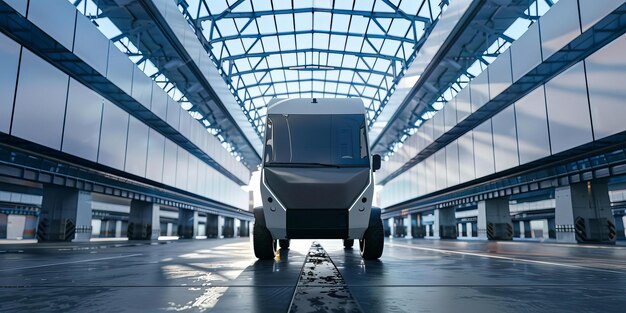Self-Driving Trucks: Future of US Logistics & Job Impact

The advent of self-driving trucks on US highways promises a transformative shift in logistics, enhancing efficiency and safety, while simultaneously sparking complex debates about potential job displacement within the trucking industry, necessitating proactive planning for workforce transitions and societal adaptation.
The landscape of transportation is on the cusp of a monumental transformation, with self-driving trucks on US highways: the future of logistics and potential job losses at the forefront of this shift. This evolution is not merely incremental but represents a fundamental reimagining of how goods move across vast distances.
The Dawn of Autonomous Trucking: A Technological Revolution
The notion of trucks operating without human intervention once belonged solely to the realm of science fiction. Today, this concept is rapidly transitioning into a tangible reality, poised to redefine the very fabric of the logistics industry. The development of self-driving truck technology has advanced significantly, moving from controlled test environments to the threshold of widespread commercial deployment on US roadways. This pivotal shift promises a multitude of benefits, from enhanced operational efficiencies to a potential reduction in road accidents, but also introduces complex economic and social challenges that warrant thorough examination.
Driving Innovation and Efficiency
The primary impetus behind the adoption of autonomous trucking lies in its potential to revolutionize operational efficiency. Traditional trucking operations are inherently constrained by human limitations, such as mandated rest periods, driving hour regulations, and susceptibility to fatigue. Self-driving trucks, however, are largely free from these constraints, enabling continuous operation around the clock.
- 24/7 Operations: Autonomous trucks can operate non-stop, dramatically reducing transit times and increasing asset utilization.
- Optimized Fuel Consumption: Advanced AI often allows for more consistent speeds and optimized acceleration/braking, leading to better fuel economy.
- Reduced Human Error: Automation can significantly lower the incidence of accidents caused by human factors like fatigue, distraction, or impairment.
The Road to Commercialization: Current Pilot Programs and Milestones
Several companies are now actively engaged in testing and deploying self-driving truck technology on public roads, albeit under specific conditions and with varying degrees of human oversight. These pilot programs are crucial for refining the technology, gathering real-world data, and addressing regulatory frameworks. For instance, companies like Waymo Via, TuSimple, and Aurora have logged millions of miles in autonomous mode, demonstrating the viability of their systems in diverse operational scenarios. Early routes often target long-haul, repetitive stretches of highway, where the driving environment is more predictable. These trials are helping to build confidence in the technology’s safety and reliability, paving the way for larger-scale commercial rollouts in the coming years. The data collected from these extensive tests will be instrumental in demonstrating self-driving trucks’ readiness for widespread integration into the national supply chain.
The journey from concept to widespread adoption is multifaceted, involving not just technological prowess but also robust regulatory frameworks, public acceptance, and significant infrastructure considerations. Each mile logged by these autonomous vehicles provides invaluable insights into optimizing performance, enhancing safety protocols, and addressing the nuanced challenges of real-world driving conditions, pushing the industry closer to a new era of logistics.
Economic Implications: Costs, Savings, and Investment
The transition to a logistics landscape dominated by autonomous trucks is not merely a technological shift; it represents a profound economic transformation. The financial implications are vast, touching upon initial investment costs, projected savings, and the overall economic landscape that will emerge from this paradigm shift. Understanding these dynamics is crucial for stakeholders across the supply chain, from manufacturers and retailers to individual consumers.
Initial Investment vs. Long-Term Savings
The upfront cost of deploying self-driving trucks is substantial. Equipping a commercial truck with the necessary array of sensors, cameras, lidar, radar, and advanced computing systems presents a significant capital outlay. Furthermore, investment is required in the supporting infrastructure, including high-definition mapping, fleet management software, and maintenance facilities adapted for autonomous vehicles. These initial expenses are a considerable barrier to entry for many traditional trucking companies.
However, these high initial costs are offset by compelling long-term operational savings. The most significant saving comes from labor costs, as autonomous trucks would require significantly less human supervision for long-haul routes. Beyond direct wages, this also includes benefits, training, and recruitment expenses associated with human drivers.
- Reduced Fuel Consumption: Precise, consistent driving by AI can optimize fuel efficiency, leading to substantial savings over time.
- Lower Insurance Premiums: Proponents argue that a reduction in accident rates due to autonomous technology could lead to lower insurance costs.
- Increased Asset Utilization: Trucks can operate continuously, maximizing revenue per vehicle and fleet efficiency.
Impact on Shipping Costs and Supply Chain Efficiency
The cumulative impact of these savings is expected to translate into lower shipping costs. This reduction would benefit various industries, from manufacturing to retail, potentially leading to lower prices for consumers and increased competitiveness for businesses. Reduced transit times, enabled by 24/7 operations, would also significantly improve supply chain predictability and responsiveness. This heightened efficiency would allow companies to optimize inventory management, decrease warehousing costs, and respond more swiftly to market demands. The ability to move goods faster and more reliably across the country would strengthen national supply chain resilience, a critical factor highlighted by recent global disruptions. Consequently, the entire logistics network could become more robust and adaptable, fostering unprecedented levels of connectivity and throughput.
Ultimately, the economic narrative surrounding self-driving trucks is one of significant upfront investment leading to transformative long-term gains. These gains are projected to ripple throughout the economy, reshaping industries, influencing pricing structures, and fundamentally enhancing the efficiency and reliability of goods movement. The potential for these economic benefits is a powerful driver for the continued development and deployment of autonomous trucking technology.
Safety and Regulation: Navigating the Legal and Ethical Landscape
The integration of self-driving trucks onto US highways hinges critically on two interconnected pillars: safety and regulation. Public acceptance, industry adoption, and legislative support are all contingent upon the demonstrated safety of these autonomous systems and the establishment of comprehensive regulatory frameworks that govern their operation. This complex interplay presents both immense opportunities for progress and significant challenges that must be meticulously addressed.
Enhancing Road Safety Through Automation
Proponents argue that autonomous trucks have the potential to vastly improve road safety. Human error is a primary cause of truck accidents, often stemming from fatigue, distraction, or impaired driving. Self-driving systems, by contrast, are designed to operate without these human limitations, theoretically leading to a reduction in accidents. Advanced sensors provide a 360-degree view around the vehicle, and AI-driven decision-making can react faster and more consistently than a human driver.
However, the complete elimination of accidents is an unrealistic expectation. Autonomous systems face their own challenges, including sensing limitations in adverse weather, the complexities of interacting with unpredictable human drivers, and the inherent challenges in programming for every conceivable edge case. The ability of these systems to reliably detect, predict, and respond to dynamic road conditions and human behavior is paramount. Continuous improvement through rigorous testing and data collection is essential to refine these capabilities.
Regulatory Frameworks and Public Perception
The regulatory landscape for autonomous vehicles is still evolving, marked by a patchwork of state-level initiatives and ongoing efforts at the federal level to establish national guidelines. Different states have adopted varying approaches to testing and deployment, creating a complex environment for companies operating across state lines. Federal agencies, notably the National Highway Traffic Safety Administration (NHTSA) and the Federal Motor Carrier Safety Administration (FMCSA), are actively working to develop comprehensive safety standards and operational rules for autonomous trucks. These regulations will need to address a myriad of issues, including:
- Testing and Certification: How will autonomous systems be validated for safety and performance?
- Accident Liability: Who is liable in the event of an accident involving an autonomous truck – the manufacturer, the operator, the software developer?
- Cybersecurity: How will these sophisticated systems be protected from hacking and other cyber threats?
- Human Oversight Requirements: What role, if any, will human operators play in autonomous trucking, especially in initial deployments?
Public perception is another critical factor. A significant portion of the public remains skeptical about the safety of autonomous vehicles. Incidents, even minor ones, involving self-driving technology can quickly erode public trust. Clear communication, transparency regarding safety data, and a phased, carefully managed rollout will be essential to build public confidence and foster acceptance. The legal and ethical implications, especially concerning responsibility in unavoidable accidents, create a dense web of considerations that demand robust debate and a well-defined legal framework before widespread adoption can truly take hold.
Workforce Transformation: Job Displacement and New Opportunities
The emergence of self-driving trucks on US highways undeniably signals a sweeping transformation of the American workforce, primarily within the trucking industry. While the efficiency gains and logistical benefits are compelling, the potential for significant job displacement among truck drivers poses a profound societal challenge. Addressing this impact proactively is crucial for a smooth and equitable transition.
Understanding Job Displacement
The most direct and widely discussed impact of autonomous trucking is the potential for job losses among the nation’s roughly 3.5 million truck drivers. As autonomous technology matures, the need for human drivers on long-haul routes, particularly those between freight hubs, is expected to diminish. This reduction could be gradual, initially involving human operators taking over for the “last mile” deliveries or supervising fleets remotely, but the long-term trend points towards large-scale automation. The implications extend beyond just drivers to potentially impact related professions such as roadside assistance, truck stop services, and certain administrative roles that support human-driven logistics. The scale of this potential displacement necessitates careful consideration and planning to mitigate adverse economic and social effects.
Reskilling and Retraining Initiatives
Mitigating the impact of job displacement requires robust and accessible reskilling and retraining programs. These initiatives aim to equip current truck drivers with new skills that are relevant to the evolving logistics landscape or other sectors of the economy. Potential new roles include:
- Autonomous Fleet Managers: Overseeing the operation and maintenance of autonomous truck fleets.
- Remote Operators/Supervisors: Monitoring autonomous trucks from a central control facility, intervening as needed.
- Last-Mile Delivery Drivers: Operating traditional vehicles for local deliveries from autonomous truck transfer hubs.
- Maintenance Technicians for Autonomous Systems: Specializing in the complex software and hardware of self-driving trucks.
- Data Analysts: Interpreting the vast amounts of operational data generated by autonomous fleets.
Government agencies, educational institutions, and industry stakeholders will need to collaborate to fund and develop these programs, ensuring they are accessible, affordable, and aligned with future job market demands. This proactive approach can help transform a potential crisis into an opportunity for workforce upskilling and diversification, ensuring that the benefits of technological progress are more broadly shared. The discussion will need to involve robust public and private partnerships.
Socioeconomic Impacts and Policy Considerations
Beyond individual job loss, the widespread adoption of autonomous trucks could have significant socioeconomic impacts on communities heavily reliant on the trucking industry. Small towns along major freight corridors, for example, might see a decline in business for truck stops, restaurants, and other services that cater to human drivers. Policymakers will need to consider measures such as:
- Unemployment Benefits and Transition Assistance: Providing robust support for displaced workers during their transition period.
- Economic Development Programs: Investing in affected communities to foster new industries and job opportunities.
- Stakeholder Engagement: Involving labor unions, industry representatives, and community leaders in the development of transition plans.
The challenge is not simply to adapt to new technology but to manage the human element of this transition with empathy and foresight. By investing in education, retraining, and community support, society can strive to ensure that the benefits of autonomous trucking are realized without leaving a significant portion of the workforce behind. This forward-looking approach is essential for ethical technological progress.
Infrastructure and Hubs: Redefining Logistics Networks
The widespread adoption of self-driving trucks will necessitate a significant evolution of America’s transportation infrastructure and the formation of specialized logistics hubs. This transformation goes beyond simply paving roads; it involves integrating advanced technologies, redesigning freight movement strategies, and creating new points of interaction between autonomous vehicles and human-centric systems.
Smart Roads and Communication Networks
For autonomous trucks to operate at their peak efficiency and safety, the existing road infrastructure will require enhancements. While current autonomous systems are designed to function independently, a future where vehicles can communicate with each other (V2V) and with infrastructure (V2I) promises even greater fluidity and responsiveness. This could involve:
- Enhanced Digital Mapping: Detailed, continuously updated digital maps are crucial for autonomous navigation.
- Dedicated Autonomous Truck Lanes: In some scenarios, specific highway lanes might be designated for autonomous trucks to optimize flow and minimize interactions with human-driven vehicles.
- Vehicle-to-Infrastructure (V2I) Communication: Traffic lights, road signs, and construction zones could communicate directly with trucks, providing real-time data for optimized routing and safety.
- High-Bandwidth Connectivity: Reliable and pervasive 5G or future wireless technologies will be vital for real-time data exchange, remote monitoring, and software updates.
These “smart road” capabilities would enable precise platooning (trucks driving closely together to save fuel), dynamic rerouting around congestion, and proactive safety warnings, further enhancing the benefits of autonomous transport. The development and deployment of such an intelligent infrastructure will require substantial public and private investment and strategic planning.
Autonomous Freight Hubs and Transfer Points
A key component of the future autonomous logistics network will be the development of specialized freight hubs and transfer points. These strategically located facilities will serve as the nexus where long-haul autonomous trucks interact with human-driven vehicles for “last-mile” delivery.
At these hubs:
- Autonomous trucks would arrive, safely park, and transfer their cargo to smaller, human-driven vehicles.
- They may also undergo recharging (for electric autonomous trucks), routine maintenance, or software updates.
- These points could become significant economic centers, generating new jobs in logistics management, maintenance, data analysis, and local delivery.
The design of these hubs will be crucial for efficiency, ensuring seamless transitions between autonomous and human operations. They will need to be equipped with automated loading/unloading capabilities, secure parking, and advanced fleet management systems. These hubs represent a fundamental redesign of how goods flow from port to consumer, optimizing efficiency while creating new points of economic activity and new skill requirements for the evolving workforce. This strategic development of an integrated infrastructure is essential for unlocking the full potential of autonomous trucking.
Environmental Impact and Sustainability
The environmental implications of integrating self-driving trucks onto US highways present a complex, yet largely positive, outlook. While the direct benefits revolve primarily around economic efficiency and safety, the broader adoption of autonomous technology in logistics holds significant promise for contributing to more sustainable transportation practices, particularly in the realm of emissions and resource consumption.
Reducing Carbon Footprint and Fuel Consumption
One of the most compelling environmental advantages of autonomous trucks stems from their potential to significantly reduce fuel consumption and, consequently, carbon emissions. Human driving behavior, characterized by variations in speed, inconsistent acceleration and braking, and suboptimal route planning, contributes to inefficiencies. Autonomous systems, conversely, are designed for precision and optimization:
- Optimized Driving Patterns: AI-driven systems maintain steady speeds, execute smoother braking and acceleration, and can follow optimal routes with minimal deviations. This precision reduces fuel waste.
- Platooning Capabilities: Autonomous trucks can drive in tight platoons, where the lead truck breaks air resistance for the following vehicles, leading to substantial aerodynamic and fuel savings.
- Predictive Maintenance: Advanced sensors and data analytics can predict maintenance needs, ensuring trucks operate at peak efficiency and reduce breakdowns that can lead to increased emissions.
The cumulative effect of these optimizations across a large fleet of autonomous trucks could lead to a noticeable reduction in the overall carbon footprint of the freight industry. This contributes directly to national and global climate change mitigation efforts.
Noise Pollution and Resource Efficiency
Beyond emissions, there are other environmental considerations. Noise pollution from heavy truck traffic is a significant concern for communities living near major highways and logistics hubs. The shift towards potentially electric autonomous trucks, coupled with smoother driving patterns, could lead to a reduction in ambient noise levels, improving quality of life for affected populations.
Furthermore, autonomous systems can enhance overall resource efficiency within the supply chain:
- Reduced Idling: Autonomous trucks can be programmed to minimize idling, saving fuel and reducing emissions during stops and loading/unloading.
- Optimized Routing: Real-time data and AI-powered route planning can minimize unnecessary miles driven, further reducing fuel consumption and wear and tear on roads.
- Fleet Lifecycle Management: With more consistent usage patterns and precise operation, autonomous trucks might experience less mechanical stress, potentially extending their operational lifespan and reducing the demand for new vehicle manufacturing.
While the primary focus today is on the economic and safety aspects, the environmental benefits of autonomous trucking are increasingly recognized as a crucial part of its value proposition. Embracing this technology, especially in conjunction with the transition to electric powertrains, offers a pathway toward a more sustainable and environmentally responsible logistics future. Integrating these benefits requires careful policy design and investment.
The Future Landscape: Challenges and Opportunities Ahead
The journey towards widespread adoption of self-driving trucks on US highways is far from complete, presenting a dynamic landscape characterized by both persistent challenges and vast opportunities. The successful integration of this transformative technology will depend on how effectively these multifaceted issues are addressed by industry, government, and society at large.
Overcoming Remaining Hurdles
Several significant challenges remain before autonomous trucks become a ubiquitous presence on American roads.
- Technological Maturity: While impressive, current autonomous driving systems are still refining their ability to navigate complex, unpredictable scenarios, such as extreme weather conditions, road debris, and highly variable human driving behavior. Ongoing research and development are crucial to achieve near-perfect reliability.
- Regulatory Harmonization: The current patchwork of state-level regulations creates logistical and legal complexities for operators. A unified, clear federal framework is essential to allow for seamless interstate operation and consistent safety standards.
- Cybersecurity Risks: Connecting a fleet of autonomous trucks to advanced networks also introduces significant cybersecurity vulnerabilities. Robust defenses against hacking and data breaches are paramount to prevent catastrophic incidents.
- Public Acceptance: Building public trust and overcoming apprehension about self-driving technology remains a critical hurdle. Transparency, demonstrable safety improvements, and effective communication will be key.
Addressing these challenges will require sustained collaboration between technology developers, policymakers, and the public, ensuring that innovation proceeds responsibly and safely.
New Business Models and Economic Growth
Despite the hurdles, the opportunities presented by self-driving trucks are immense. The technology promises to unlock new business models and drive significant economic growth.
- Logistics-as-a-Service (LaaS): Companies might shift from owning fleets to subscribing to LaaS, leveraging autonomous trucks for on-demand freight movement.
- Optimization of Supply Chains: Reduced transit times and increased precision will allow businesses to implement “just-in-time” inventory systems more effectively, reducing warehousing costs and improving responsiveness to market demands.
- Rural Economic Development: Autonomous trucks could make remote areas more economically viable for manufacturing and agriculture by reducing transportation costs, fostering new regional industries.
- Technological Spin-offs: The innovations developed for autonomous trucking, such as advanced sensor technology, AI algorithms, and predictive maintenance systems, have applications in numerous other industries, creating a ripple effect of technological advancement and job creation beyond logistics.
The future landscape of logistics is poised for a dramatic reshaping. While the road ahead will undoubtedly feature complexities and require careful navigation, the strategic and thoughtful integration of self-driving trucks could usher in an era of unprecedented efficiency, safety, and economic expansion, fundamentally changing how goods are moved across the nation. This will require vision and adaptability from all stakeholders.
| Key Aspect | Brief Description |
|---|---|
| 🚚 Efficiency Gains | Autonomous trucks promise 24/7 operation and optimized routes, significantly reducing transit times and improving logistics flow. |
| 👨💻 Job Transition | Potential job displacement for drivers, but new roles in fleet management and maintenance will emerge, requiring retraining initiatives. |
| 🚦 Safety & Regulation | Designed to reduce human error accidents, but require robust regulatory frameworks and public acceptance for widespread adoption. |
| 🌿 Environmental Benefits | Optimized driving and platooning can lead to reduced fuel consumption and lower carbon emissions, enhancing sustainability. |

Frequently Asked Questions About Self-Driving Trucks
Yes, self-driving trucks are currently operating on US highways, primarily through pilot programs and test deployments. Companies like Waymo Via, TuSimple, and Aurora are actively testing their autonomous technology on public roads in specific states, often with a safety driver onboard. Full commercial deployment is still in its early stages.
The widespread adoption of self-driving trucks is expected to displace a significant number of long-haul truck driving jobs. However, it will also create new roles, such as autonomous fleet managers, remote operators, maintenance technicians for advanced systems, and last-mile delivery drivers. Reskilling and retraining initiatives will be crucial for a smooth transition.
Proponents argue that autonomous trucks have the potential to be safer due to the elimination of human error factors like fatigue and distraction. While autonomous systems are designed for consistent, precise operation, they are still evolving to handle all complex road conditions. Data from ongoing tests is continuously assessed to prove and enhance their safety performance.
While autonomous trucks can operate on existing roads, full optimization may require enhancements like high-definition digital mapping, V2V and V2I communication networks, and potentially dedicated autonomous truck lanes. Additionally, new autonomous freight hubs will be needed as transfer points between autonomous long-haul and human-driven last-mile delivery.
Self-driving trucks offer environmental advantages through optimized driving patterns, leading to reduced fuel consumption and lower carbon emissions. Features like platooning, precise acceleration/braking, and minimized idling contribute to greater fuel efficiency. If combined with electric powertrains, they promise even greater reductions in both air and noise pollution.

Conclusion
The integration of self-driving trucks onto US highways heralds a transformative era in logistics, promising unprecedented efficiencies, enhanced safety, and environmental benefits. While the technological advancements are impressive, the journey ahead is complex, requiring careful navigation of regulatory challenges, substantial infrastructure investments, and, critically, proactive strategies to manage the socioeconomic impacts on the workforce. The future of freight is undoubtedly autonomous, but its successful realization depends on a collaborative, forward-thinking approach that balances innovation with societal well-being, ensuring a smooth transition that benefits all stakeholders.





